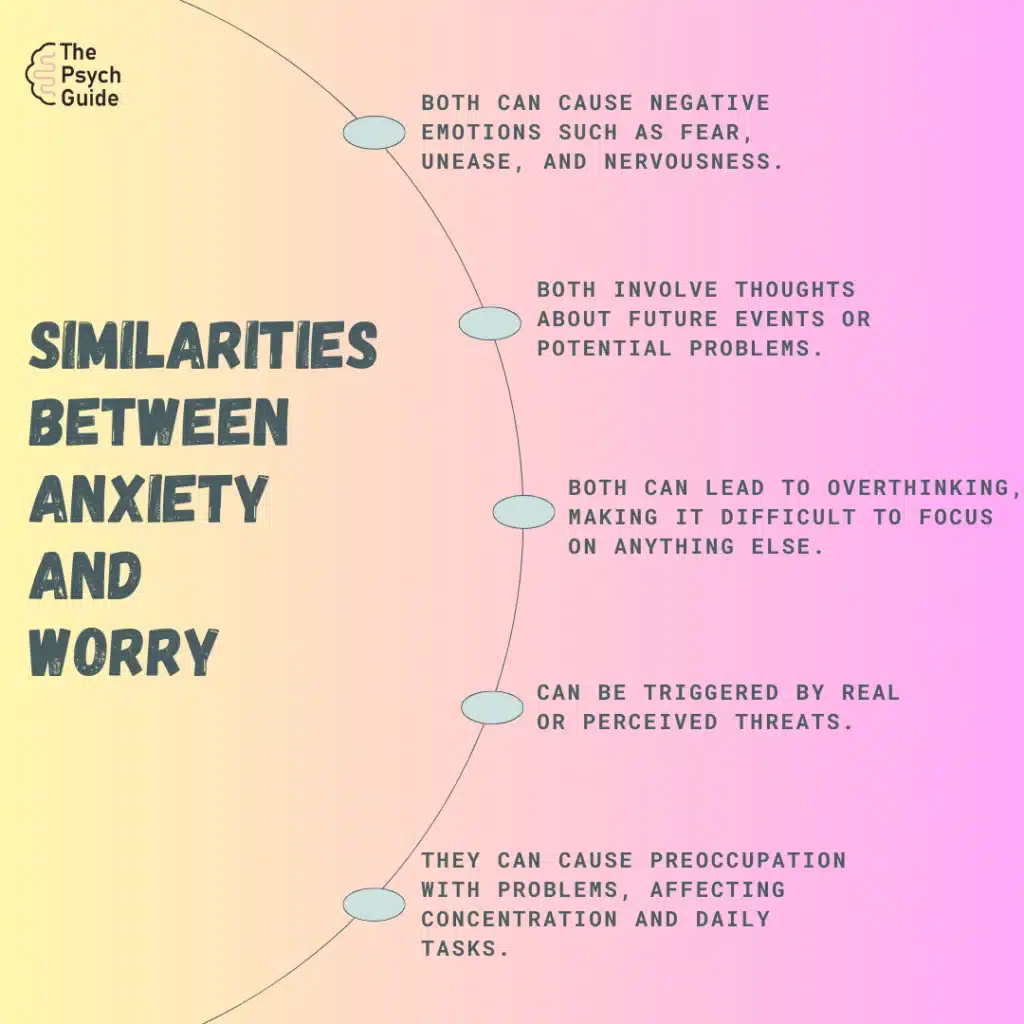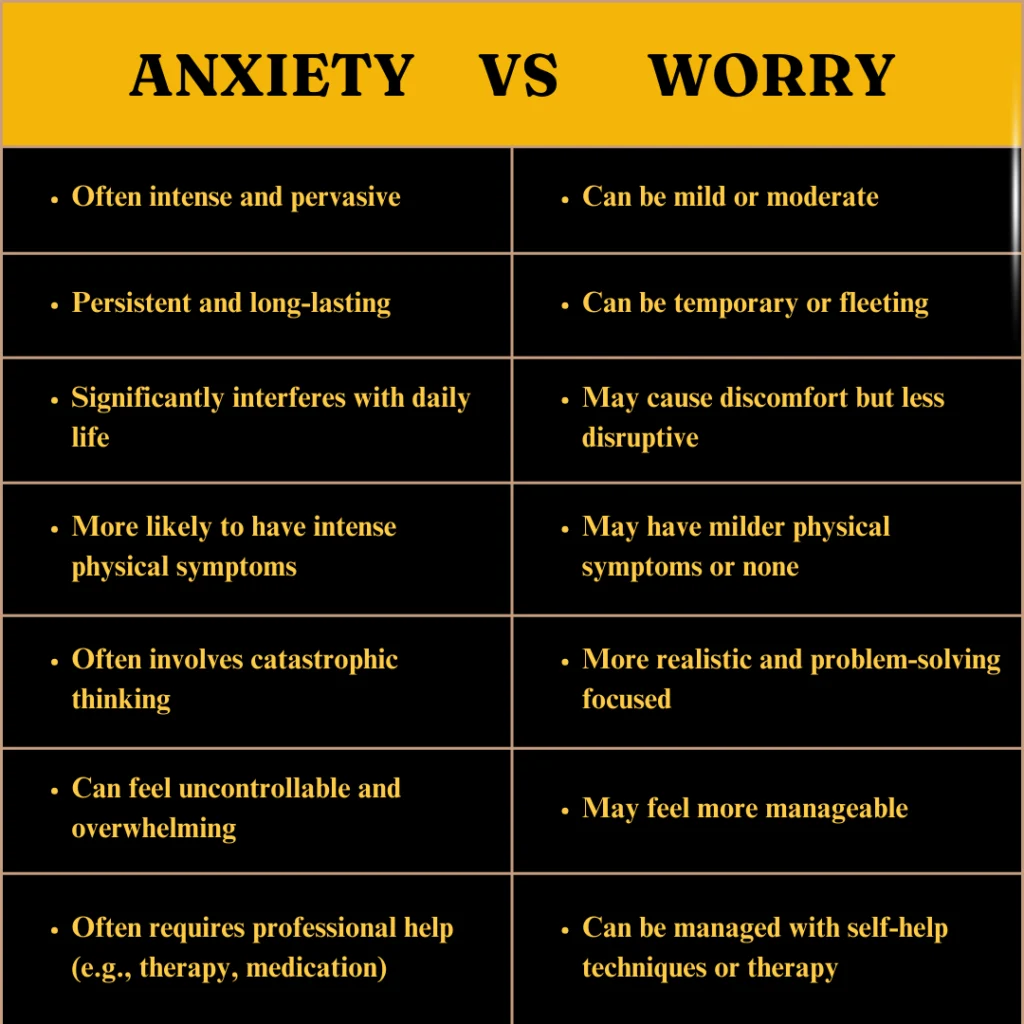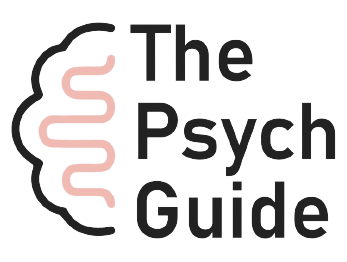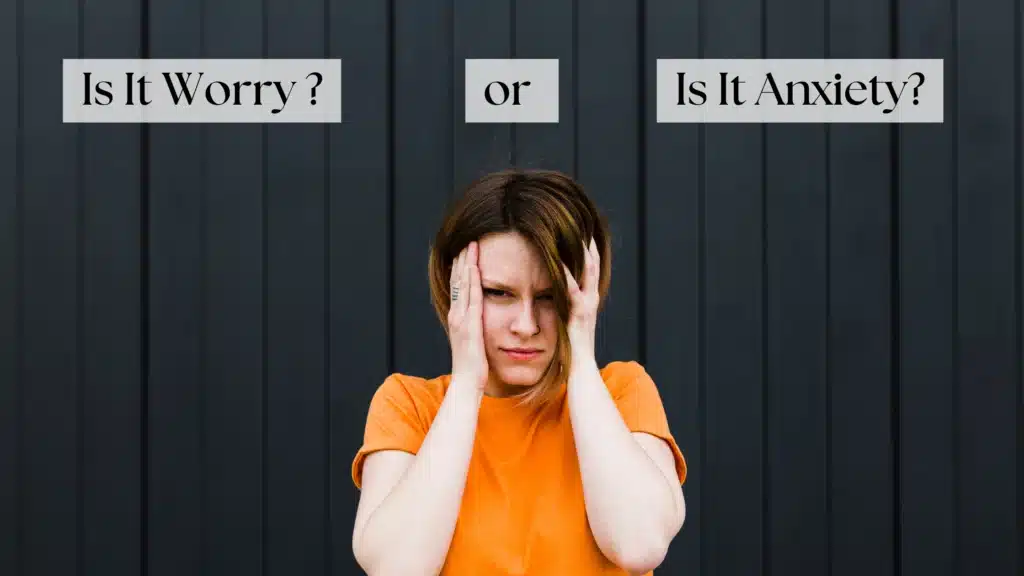Have you ever found yourself overwhelmed by thoughts and emotions, unsure whether you’re experiencing anxiety or just regular worry? This is a common dilemma many people face. The difference between anxiety and worry can be subtle, making it difficult to distinguish between the two. Sometimes, the line is so thin that recognizing which one you’re dealing with becomes a challenge.
While anxiety and worry are often confused with one another, understanding their differences can help you manage your feelings more effectively.
So do you want to know that what you are feeling is just a fleeting worry or something more serious like anxiety? If yes, then stick with us, as this blog post is all about anxiety and worry. We’ll not only explore the difference between anxiety and worry but also dive into their similarities, giving you a deeper understanding of both. Plus, you’ll discover helpful tips to manage your anxiety or worry effectively. And don’t forget to check out our recommendations for the best-selling books that can help you cope with these emotions by the end of the blog.
Table of Contents
ToggleWhat is Anxiety?
Before we discuss the difference between anxiety and worry, let’s first understand what anxiety is.
Anxiety is a mental and emotional state that causes feelings of fear, apprehension, and unease, often accompanied by physical symptoms such as rapid heart rate, increased blood pressure, sweating, restlessness, and muscle tension. Anxiety can persist without a clear cause and may interfere with daily functioning, as it triggers both psychological and physiological responses to perceived or potential threats.
Prevalence
According to large population based surveys, it is shown that up to 33.7% of the population gets affected by anxiety during their lifetime. Additionally, research shows that the rate of anxiety disorders increased by 76.2 million cases during COVID-19 pandemic and females were more affected than males.
Symptoms of Anxiety
Anxiety can interfere with our daily lives. Here are some common symptoms of anxiety:
Mental symptoms
- Excessive worry or fear
- Feeling restless or on edge
- Having trouble concentrating
- Intrusive thoughts
- Irritability
- Difficulty falling or staying asleep
Physical symptoms
- Increased heart rate
- Rapid breathing (hyperventilation)
- Sweating
- Fatigue
- Muscle tension
- Headaches
- Stomach aches
- Nausea
What is Worry?
Worry is a normal human emotion that everyone experiences from time to time. It involves a mental process of thinking about potential negative events, their consequences, and possible outcomes. Worry can often be described as repetitive, obsessive thoughts focused on problems or uncertainties.
In some situations, worry can be helpful, such as motivating us to prepare for exams and an important presentation. But, when it becomes excessive and tends to interfere with daily life, it can be a symptom of an anxiety disorder.
Here are some signs that your worry may be excessive:
- Worrying about things that are unlikely to happen.
- Having difficulty controlling your worry.
- Worrying that interferes with your ability to function at work, school, or in your social life.
Excessive worry can also lead to physical symptoms such as fatigue, trouble sleeping, or muscle tension. In severe cases, persistent worry can develop into anxiety.

What is the Difference Between Anxiety and Worry?
Understanding the difference between anxiety and worry is essential for managing them effectively. While both involve concerns about potential problems, they differ in their intensity, duration, and impact on daily life. Let’s explore these differences one by one:
1. Nature of the Concern
- Worry is specific to a situation or event. It involves thinking about everyday issues like relationships, finances and health. Worry tends to be future-focused but grounded in reality. People worry about things that could potentially happen, but these worries are usually based on logical concerns.
- Anxiety, on the other hand, tends to be more generalized and often lacks clear focus. It’s a continuous feeling of unease, often about imagined or irrational threats that may or may not be rooted in reality. It can lead to catastrophic thinking, where the mind automatically jumps to the worst possible outcome, even when it’s unlikely. This can create a cycle of negative thinking, which exacerbates anxiety over time.
2. Intensity and Duration
- Worry is typically for a short period of time and milder in intensity. Worry subsides once the issue at hand is resolved. It’s a normal part of life, and most people experience it as a temporary state that they can cope with.
- Anxiety, however, tends to be long-lasting and more intense. It can persist even after the original concern has passed or when there’s no specific problem. Anxiety often lingers for weeks, months, or even years, interfering with daily life and overall well-being.
3. Physical Symptoms
- Worry does not manifest physically. It can be asymptomatic, showing no physical symptoms. But when it becomes excessive then it might cause mild discomfort, such as headaches or stomachaches.
- Anxiety, however, often causes significant physical symptoms. These can include a racing heart, shortness of breath, dizziness, sweating, muscle tension, and even panic attacks. Anxiety can trigger the body’s “fight or flight” response, causing significant physical distress.
4. Level of Control
- Worry is generally something people feel they have control over. While it may be uncomfortable, individuals can usually manage their worries through problem-solving, talking it out, or using coping strategies.
- Anxiety often feels uncontrollable. People with anxiety may feel overwhelmed by their feelings and unable to manage them, no matter how hard they try. This lack of control can make anxiety even more distressing.
5. Impact on Daily Life
- Worry usually doesn’t severely disrupt daily life. While it can be uncomfortable, most people can continue functioning and fulfilling their responsibilities despite feeling worried.
- Anxiety can be debilitating. It can interfere with work, school, and relationships, making it difficult to concentrate, perform tasks, or even leave the house. Severe anxiety can cause people to engage in avoidance behaviors, such as avoiding situations or people they used to find enjoyable or necessary.
6. Underlying Causes
- Worry is usually driven by specific external events or concerns. It may be triggered by an upcoming deadline, a financial issue, or a disagreement with someone. Once the external issue is resolved, the worry typically fades.
- Anxiety, however, often has deeper roots. It can be caused by a combination of genetic, psychological, and environmental factors. Sometimes, there may not be a clear external cause for anxiety, as it can stem from underlying mental health conditions, trauma, or chemical imbalances in the brain.
7. Relationship to Other Conditions
- Worry is typically an isolated experience. While it may contribute to stress, it is not usually linked to other mental health conditions.
- Anxiety, on the other hand, is often connected to other mental health issues such as depression, obsessive-compulsive disorder (OCD), or post-traumatic stress disorder (PTSD). People with anxiety may also experience comorbid conditions, where anxiety exists alongside other mental health challenges, exacerbating symptoms.
So now you are aware of the difference between anxiety and worry. Recognizing the nuances of anxiety vs worry can help you better manage your emotional health and know when additional support may be needed.

Treatment of Anxiety and Worry
After reading the difference between anxiety and worry, it’s important to seek appropriate treatment if either condition is significantly impacting your daily life.
While mild worry is a normal human emotion, persistent and excessive anxiety or worry can require professional help.
Treatment options may include:
Therapy
- Cognitive behavioral therapy (CBT): CBT is the most common type of therapy that is used for treating anxiety disorders. It helps you to identify and change negative thought patterns that can cause and contribute to anxiety.
- Exposure therapy: Exposure therapy also helps with anxiety and worry as it involves gradually exposing yourself to the things that you fear in a safe and controlled environment under supervised guidance. This can help you to learn to manage your anxiety in a healthy way.
- Acceptance and commitment therapy (ACT): ACT helps you to accept your thoughts and feelings without judgment and to commit to living a meaningful life. When you accept your thoughts and feelings without judgment, it helps you to heal them and work on them gradually.
Medications
- Antidepressants: Many antidepressants, such as selective serotonin reuptake inhibitors (SSRIs), can be helpful in treating anxiety disorders.
- Anti-anxiety medications: Anti-anxiety medications, such as benzodiazepines, can provide quick relief from anxiety symptoms, but they should only be used for short-term relief because they can be addictive and you should also consult a health care professional before taking any medication, as they can prescribe you medications according to your health and any specific concern.
Practical Tips for Managing Anxiety and Worry
Let’s explore some tips for managing anxiety and worry:
- Challenge your thoughts: When you feel anxious, try to identify the thoughts that are causing your worry and anxiety. Know your triggering thoughts. Are they realistic? Are they helpful? Often, anxious thoughts are exaggerated or unhelpful. Try to question these thoughts with more balanced and realistic ones.
- Relaxation Techniques: Practice relaxation techniques like deep breathing exercises, yoga, mindfulness meditation, or progressive muscle relaxation. These techniques can help to calm and soothe your body and mind in the moment. There are many free resources available online and on apps to help you learn these methods.
- Focus on the present: Anxiety often involves worrying about the future and keeping you engaged in anticipation of negative outcomes. Try to focus on the present moment, as it can help reduce the negative thoughts that contribute to worry and anxiety. Ask yourself: What is happening right now? What can you control? Grounding techniques or mindfulness exercises can be helpful for this.
- Talking it Out: Sometimes, discussing your worries with a friend, family member, or therapist can provide a new perspective. External input can help you see solutions that you may not have considered, easing the burden of worry. Talking about how you feel can be a big relief and letting your heart out may make you feel lighter.
- Take care of yourself: Are you taking care of yourself? Make sure you are getting enough sleep, eating a healthy diet, and exercising regularly. These lifestyle preferences can all contribute to decreasing anxiety and worry.
- Limit caffeine and alcohol: While they may seem calming in the short term, caffeine and alcohol can actually exacerbate anxiety signs in the long run.
There are effective tips to manage anxiety and worry. By trying some of the tips mentioned above and seeking professional help if needed, you can learn to cope with anxiety and live a happier, more fulfilling life.
Best Selling Self-Help Books for Anxiety and Worry

There are many self-help books available that can help tackle anxiety and worry.
- “Overcoming Unwanted Intrusive Thoughts“ by Sally M. Winston PsyD and Martin N. Seif PhD is a practical guide for breaking free from distressing thoughts that can disrupt daily life. Using proven CBT techniques, this book helps readers regain control and find peace of mind. It teaches how to face and manage obsessive or frightening thoughts without fear. Clear, compassionate, and easy to follow, it’s a powerful resource for anyone struggling with intrusive thinking.
- “The Anxiety and Phobia Workbook“ by Edmund J. Bourne, PhD, is a trusted guide to help readers overcome anxiety and fears. Packed with practical exercises and proven strategies, it provides tools to manage anxiety, panic attacks, and phobias. Whether facing social anxiety, health fears, or general worry, this workbook offers step-by-step guidance to regain control. Clear and supportive, it’s a valuable resource for anyone seeking relief from anxiety and a path to a calmer life.
- “Rewire Your Anxious Brain“ by Catherine M. Pittman, PhD, and Elizabeth M. Karle, MLIS, combines neuroscience and practical advice to help readers understand and overcome anxiety. This book explains how the brain’s fear center works and offers science-based techniques to break the cycle of anxiety, panic, and worry. By retraining the brain, it empowers readers to take control of their mental health. Clear, insightful, and practical, it’s a must-read for anyone seeking lasting relief from anxiety.
- “Unwinding Anxiety“ by Judson Brewer reveals groundbreaking science on how to break free from the cycles of worry and fear that fuel anxiety. This book teaches readers how to rewire their brains, replacing anxious habits with healthier, calming ones. Using a blend of neuroscience and mindfulness, it offers simple yet powerful tools to heal the mind. Clear and engaging, this guide helps readers find peace and take control of their anxiety for good.
- “Anxiety Rx“ by Dr. Russell Kennedy offers a fresh and personal approach to anxiety relief from a doctor who understands it firsthand. Blending medical knowledge with his own experience, Dr. Kennedy provides practical tools to calm the anxious mind and heal from within. This book goes beyond traditional methods, focusing on the connection between mind and body to bring lasting peace. Compassionate and empowering, it’s a transformative guide for anyone seeking true anxiety relief.
Conclusion
In this blogpost, we read about the difference between anxiety and worry, what are their similarities and how to deal with them. Knowing about their differences is necessary so you could be able to diagnose whether you are going through a normal worry or an anxiety disorder.
Mental health is a vast topic and when we dive deep into it, we find so many mental problems linked with each other. The main aim of this blogpost is to look at the difference between anxiety and worry, so you could be able to know what you are going through.
It’s important to reach out to professionals if you find signs of mental health disorder, as the counselor and therapist can tell clearly what you are going through and provide you with better treatment options available according to your health.
FAQs
Can you worry without anxiety?
Yes, you can worry without experiencing anxiety. Worry typically involves specific concerns about real-life issues and is often temporary, focusing on problem-solving. It is a normal part of life and doesn’t usually cause significant distress. Anxiety, on the other hand, is more intense and persistent, often without a clear cause, and can involve irrational fears. So, while worry can exist on its own, anxiety usually involves a more pervasive sense of unease.
What does anxiety feel like?
Anxiety manifests physically and psychologically. Physically, it can cause a racing heart, sweating, trembling, shortness of breath, and muscle tension. Psychologically, you can look at it in the form of worry, nervousness, fear, irritability, and difficulty concentrating.
What is the 3-3-3 rule for anxiety?
The 3-3-3 rule for anxiety is a technique that involves the following steps:
1. Look around and name three things you see.
2. Listen and name three sounds you hear.
3. Move and name three parts of your body that you can move.
This exercise is designed to help calm racing thoughts and bring focus to the present moment, providing an effective way to manage anxiety.
Why do I feel so much worry?
You can be worried due to various internal and external factors. Internal factors include your personality, beliefs, and past experiences, which can contribute to how you react to stressful situations. If you have a perfectionist nature or you have been through any trauma in the past then you are going to be more prone to worry.
External factors that trigger feelings of worry are relationship issues, financial problems, or work related stress.
What is the difference between anxiety and worry, and stress?
The difference between worry, stress, and anxiety lies in their focus and impact:
- Worry is a cognitive process focused on specific concerns or problems, usually related to future events. It’s often temporary and involves thinking through potential outcomes.
- Stress is a physical and emotional response to external pressures or demands. It typically arises from a specific situation, like work or personal responsibilities, and can be short-term or long-term depending on the pressure.
- Anxiety is a more pervasive feeling of unease that may not have a specific trigger. It’s often a response to imagined or future threats and can persist even when there’s no immediate cause, leading to physical symptoms and affecting daily life.

